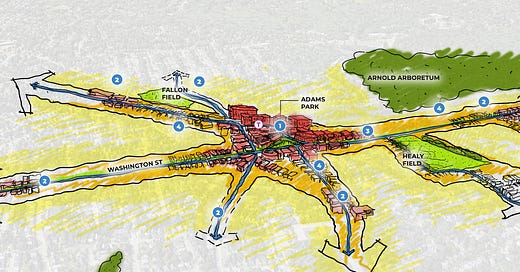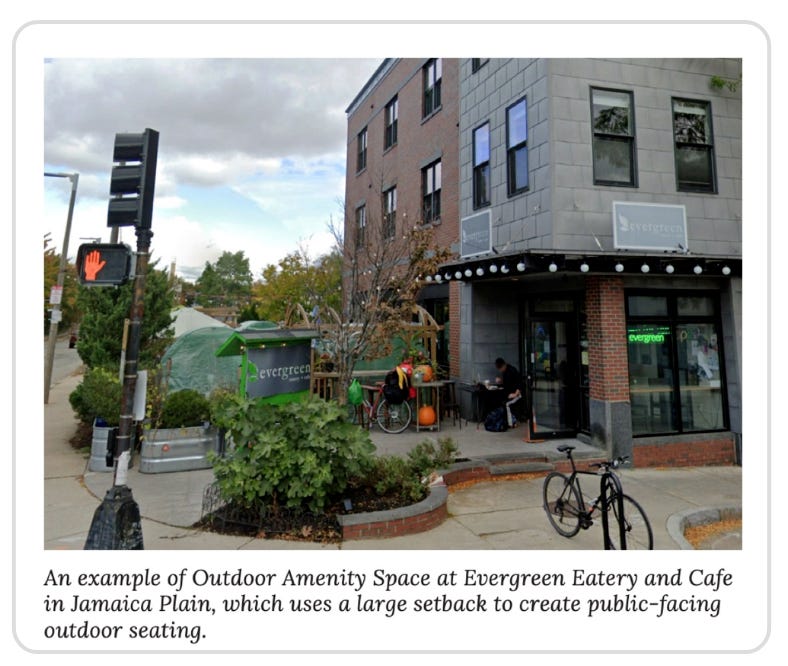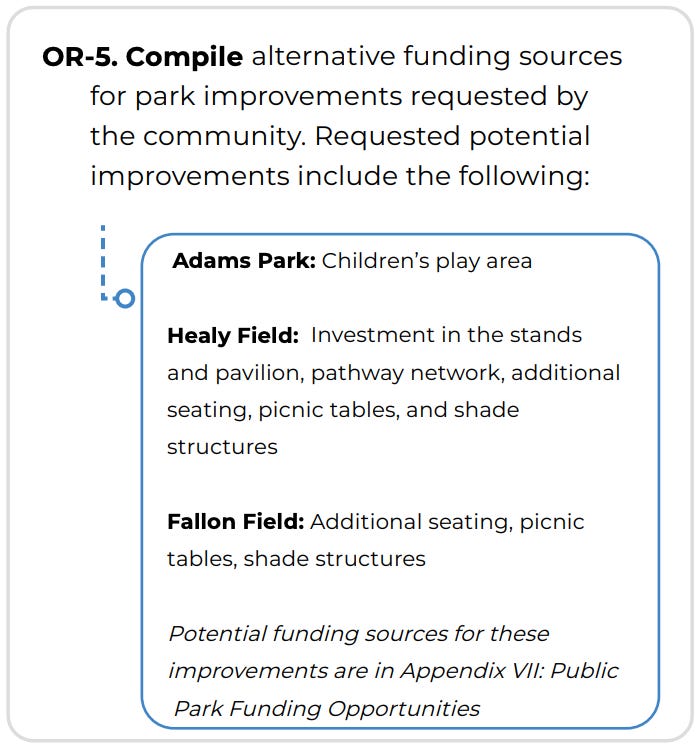The Planning Department released the Roslindale Square Small Area Plan last month. It defines a neighborhood vision for new public investment and housing development, and sets the stage for February’s draft zoning changes.
There’s a lot to like in this plan, and in this post I share what’s got me most jazzed (I’ll add some concerns and critiques in the next post). The sections below follow the same sequence as the Plan, and include visuals lifted from the document for easy reference.
Public comments on the Plan are open until January 31 – make your voice heard! If you’re excited about more housing and strengthening the Square’s dynamism and walkability, then you might find this volunteer-built public comment helper handy!
Land Use & Design Framework
I love “Community Vision 2” in the Emerging Land Use Visions section. The Planning Department acknowledges the sizable constituency for significant upzoning and housing growth in Roslindale. And not just in the commercial core, but throughout the residential fabric as well.
The Planning Department has envisioned 6-7 story buildings in the heart of the Square, and they look fantastic. They will also activate our local businesses with hundreds of new patrons who can travel by foot to visit their favorite local shops and services.
An underrated aspect of the new Squares + Streets zoning districts is that they encourage more thoughtful use of the spaces not occupied by buildings. Wider sidewalks, more greenery and permeable surfaces, plazas and outdoor seating areas. We will see more of this stuff as parcels redevelop under this new zoning regime.
Creating a Through Block1 on Taft Court between South St. and Corinth Street is a very interesting concept. This area is currently a free-for-all, with no driving lines, some cars using it as a thru street from Corinth, and others illegally turning into it from South St. It’s very pedestrian unfriendly, especially for people with kids or with mobility issues trying to access the Village Market from the South St. side. The through block would be a huge improvement.
I’m excited that the Planning Department is considering allowing for more multifamily housing (i.e. 3 or more homes per building) on important streets like Robert, Firth and Florence. While I’d much rather see small multifamily zoning extend throughout the neighborhood’s residential fabric, this at least suggests an openness to rezoning areas outside of the commercial core and major corridors of Washington, Belgrade, and Cummins.
Housing & Real Estate
Prioritizing the acquisition of older, naturally-occurring affordable housing is a good move. I can see this being implemented to spruce up triple decker rentals for the benefit of their tenants.
Small Business
I like that the plan encourages the exploration of a flexible entertainment space that could be used for film screenings and other events.
It’s important to promote commercial stability, and one promising pathway is to assist business owners with exploring coop models. Notably, both the Village Market and Rozzie Bound started as cooperatives, with the latter still operating as one today!
It’s a good idea to research whether it would make sense to limit store size and/or types through zoning in order to support small businesses. I don’t know if such policies would actually be effective, but it’s worth finding out!
Systematically tracking commercial vacancies is a no-brainer. We need tools to monitor if our land use policies are having the intended effect. While not as much of a concern in Roslindale, many urban centers have zoned for too much ground floor commercial, leading to a glut of expensive-to-build yet underutilized retail space.
Arts & Culture
Assuming a “location-specific entertainment license” will streamline the long and burdensome process of gaining approval to host events in public spaces, then I support this.
Having recently helped organize a public event at Fallon Field, I’ve witnessed how public events can require up to a half dozen licenses and permits from different City departments with varying degrees of responsiveness and friendliness. It's a complicated and time-intensive process, and a big disincentive for would-be organizers.
Transportation & Public Realm
Restoring two-way Washington Street unlocks many possibilities: increased pedestrian safety for those crossing South Street, expanded open space at Adams Park, a new bus stop on Washington, and the conversion of Poplar into a shared street.
A shared Poplar Street would then be available for more regular closures during the Farmers Market and other events, better activating our public space and driving more foot traffic to our businesses.Prioritizing shade and cooling in the Square to mitigate urban heat is key. Walking on Corinth Street in July can feel like being in an Easy-Bake Oven.
That said, the Plan appears to pay relatively little attention to shade structures along streets and sidewalks, instead heavily favoring street trees. Street trees are a great long-term solution, but not as great in the short-to-medium term. They take a long time to provide adequate shade, and need a lot of upkeep. But we need the shade now. There are a number of efforts across the US to quickly implement modern shade structures in the public realm. Let’s not give this intervention short shrift.Adding a children’s play area to Adams Park is a great idea. Investing in pathways, seating, and shade at Healy and Fallon would be good investments, too. One addition I’d make: give Fallon a water fountain!
Fallon has two basketball courts, a hockey rink, a tennis court, a playground with a splash pad, and a baseball field that doubles as a dog park. And yet it lacks a water fountain? A fountain is important beyond just convenience for those who forgot to bring a water bottle – it's a health and safety issue. The playground has essentially no shade outside of the splash pad area, and on hot summer days, it is easy to dehydrate quickly. There have been a number of occasions where I've had to call my kids' playtime short due to a lack of water on hand.
A through block is a pedestrian pathway that cuts through the middle of a city block, allowing people to walk directly from one street to another without having to go around the entire block perimeter.






















